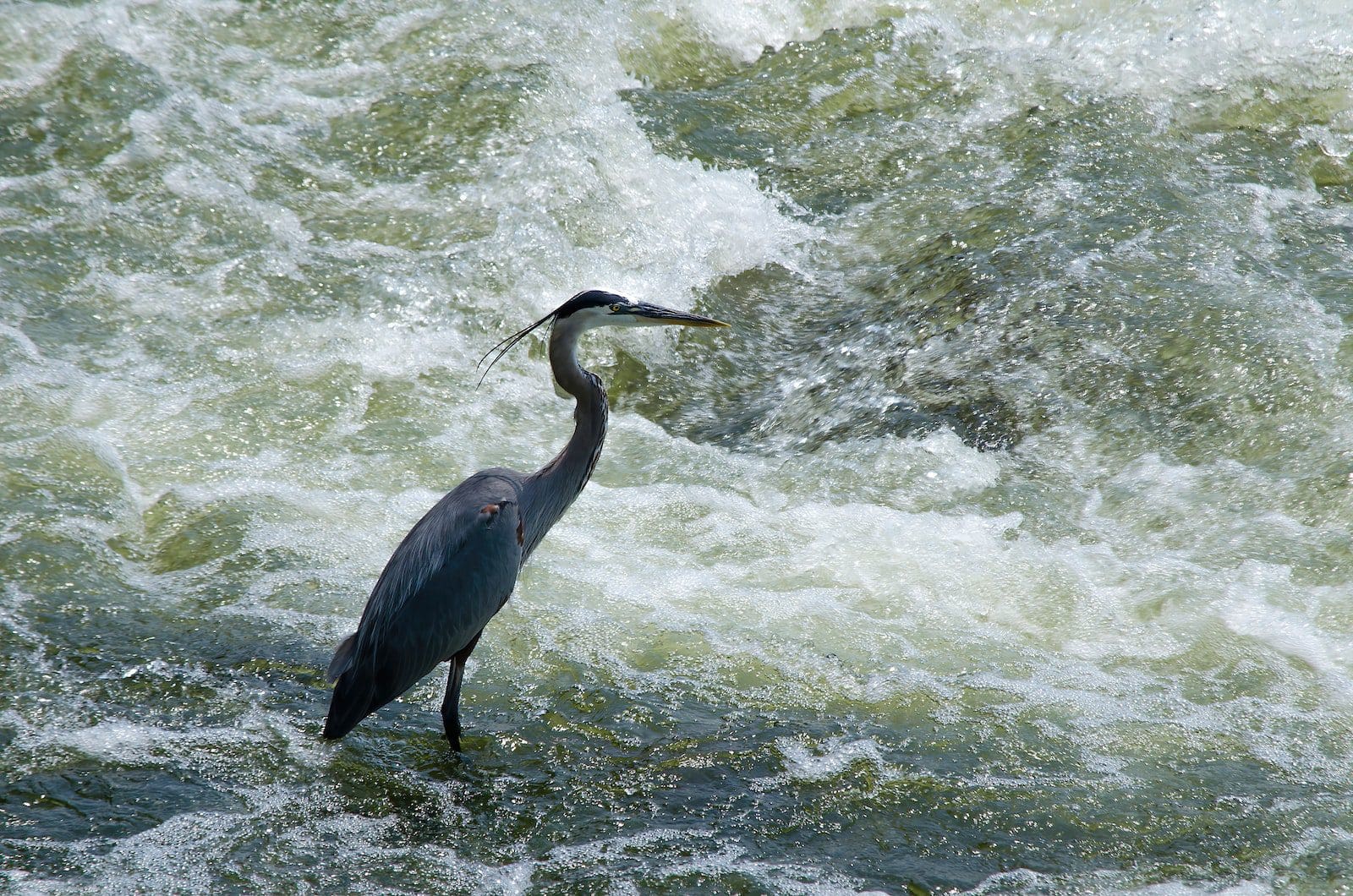Egrets and herons are both long-legged birds. They belong to the same Ardeidae family and look almost the same, but they can be differentiated in a few distinct features.
Both birds prefer lowland areas, margins of rivers, lakes, and ponds, and they are aquatic birds.
These birds are found in the tropical climate. Apart from the extremely cold climates, the birds are found everywhere.
Egrets are a type of heron. It is white, and they develop ornamental nuptial plumes during breeding. They like to perform elaborate mating displays involving the plumes.
Herons have distinct S-shaped necks. While flying, their leg trails loosely, and the head is held back against the body. Herons have sharp wings and long, straight, pointed bills.
Key Takeaways
- Herons and egrets are both species of long-legged wading birds in the Ardeidae family; herons are larger and have a more varied diet.
- Herons have heavier bills and can catch larger prey, such as fish, frogs, and snakes; egrets have slender, pointed bills and eat small fish and invertebrates.
- Herons have more colorful plumage, including blue, gray, and brown tones; egrets are white, with some species having yellow or orange accents during mating season.
Difference Between Heron and Egret
The difference between herons and egrets is their height. Typically the egrets are smaller birds in comparison to herons.
But there are also a few breeds of egrets larger than the herons. Also, egrets have black legs with a white phase, whereas herons’ legs are more lightly colored.

Comparison Table for Heron vs. Egret
| Parameter of Comparison | Heron | Egret |
|---|---|---|
| Biological Name | Ardeidae | Adea alba |
| Genera | There are around 21 genera | There are 4 genera |
| Legs | They have lighter legs | They have black legs with white-phase |
| Height | Usually taller | Considerably shorter than Heron |
| Beak | They have heavier beaks | They have lighter beaks |
What is Heron?
Heron is a long-legged and long-necked bird. They reside in both freshwater and the coast.
They belong to the family of Ardeidae along with 64 other recognized species like egrets and bitterns. These birds do not swim.
The smallest size of the heron is the dwarf bittern which measures around 25-30 cm in length, and the largest is the goliath heron which is around 152 cm tall.
The neck of these birds can bend in an s-shape because they have 6 vertebrates in their neck. Their neck retracts and extends during the flight.
Herons are a huge family of birds with a cosmopolitan distribution. They are found in all the countries except Antarctica; apart from the extremely cold places, herons are found everywhere.
Three are almost 21 genera of herons, namely- Cochlearius, taphophile, tigrisoma, tigriornis, zonerodius, zebrilus, lxobrychus, botaurus, pikaihao, zeltornis, nycticorax, nyctanassa, gorsachius, butorides, agamia, pilherodius, ardeola, Bubulcus, proardea, ardea, syrigma, and egretta
Herons are highly mobile birds, and most of them are partially migratory. These birds migrate after breeding.
They migrate in search of new feeding places and reduce pressure in the nearby areas they have been around. They migrate at night.
Habitat and Distribution of Heron
Geographic Range
Herons have a global presence, with different species distributed across six continents. They can be found in tropical and temperate regions, adapting to various climates and ecosystems. Some of the most common heron species include the Great Blue Heron (Ardea herodias), Little Egret (Egretta garzetta), and Black-crowned Night Heron (Nycticorax nycticorax).
Preferred Habitat
Herons inhabit wetland environments, using various aquatic habitats for their foraging and nesting needs. These habitats include freshwater and saltwater marshes, swamps, lakes, rivers, ponds, estuaries, and coastal areas. The availability of shallow water, dense vegetation, and an abundant food supply are key factors that attract herons to these areas.
Depending on their species and specific requirements, herons can be found in different microhabitats in their preferred wetland habitats. Some species prefer open water, while others are commonly found in areas with tall vegetation or forested surroundings. For example, the Green Heron (Butorides virescens) tends to inhabit densely vegetated areas near water bodies, whereas the Great Egret (Ardea alba) is found in open marshes or shorelines.
Migration Patterns
Migration patterns among heron species can vary significantly. While some herons are non-migratory and remain in their preferred habitats year-round, many species undertake seasonal migrations to optimize their foraging opportunities or seek more favorable breeding grounds.
Migration routes and distances vary depending on the species and their geographic range. Some herons migrate relatively short distances, while others undertake impressive journeys spanning thousands of miles. For instance, the Arctic Tern (Sterna paradisaea), closely related to herons, holds the record for the longest migration of any bird, traveling from the Arctic to the Antarctic and back each year.
Behavior and Diet of Heron
Feeding Habits
Herons are primarily piscivorous, meaning they primarily feed on fish. Their slender beaks and long necks are well adapted for capturing and consuming fish. They employ various feeding techniques, including patience and stealth, to successfully catch their prey.
When hunting, herons can be observed standing motionless or wading slowly through shallow waters, with their necks coiled in an S-shape. This posture minimizes their visibility to potential prey and allows them to strike with lightning speed when an opportunity arises. They impale fish, amphibians, crustaceans, and occasionally small mammals or reptiles using their sharp beaks.
Breeding Habits
Breeding behaviors among heron species vary, but many display impressive courtship rituals and nest-building activities. These behaviors involve elaborate displays, vocalizations, and intricate dances to attract mates and establish pair bonds.
Nesting sites for herons are located in trees or dense vegetation near water bodies. These colonies, known as heronries or rookeries, can contain hundreds to thousands of nests. Herons are known for their large stick nests, which they construct in elevated areas to protect their eggs and young from predators.
Social Behavior
While herons are solitary birds during their feeding activities, they exhibit social behaviors during the breeding season and when nesting in colonies. These colonies offer benefits such as increased protection against predators, shared information on food sources, and opportunities for mate selection.
Herons engage in various social interactions within the colony, including courtship displays, territorial defense, and communication through vocalizations and visual cues. They establish hierarchies and defend their nesting territories, displaying aggressive behaviors towards intruders or rival individuals.

What is Egret?
Egrets are a type of heron. They have white and buff plumage.
During the breeding seasons, they develop fine plumes, milky white. The term egret has been derived from the French word “aigrette,” which means “silver heron” and “brush,” referring back to the long filamentous feathers (plumes) that are seen in the egret’s back.
Egrets are also a member of the genera Egretta or ardea. In the 19th century and early 20th century, few of the species of egret were under the endangered category due to their relentless hunting of them for their plumes for the making of hats and premium clothing in Europe and the US.
Egrets prefer streams, lakes, humid forests, and other wetland environments. They prefer consuming small fishes, amphibians, reptiles, and mammals.
They build untidy nests on the trees or bushes on the ground.
Habitat and Distribution of Egret
Geographic Range
The geographic range of a species encompasses the entire area or region in which it is found. It defines the boundaries within which the species naturally occur and can be observed. The range can vary significantly depending on the species, with some having a narrow distribution limited to a specific locale, while others may have a widespread distribution spanning multiple continents.
Preferred Habitat
The preferred habitat of a species refers to the specific type of environment or ecological setting in which it thrives and displays a higher degree of adaptation. This habitat provides the necessary resources, such as food, water, shelter, and breeding sites, that are essential for the survival and reproductive success of the species. The preferred habitat can differ among species, depending on their specific ecological needs and adaptations.
Migration
Migration is a phenomenon observed in many animal species, where individuals or populations undertake regular, seasonal movements between different geographic locations. Changes in food availability, climate, or breeding requirements drive migration. It is a strategic behavior that allows animals to take advantage of favorable conditions in different areas throughout the year.
During migration, animals cover long distances and may exhibit remarkable navigation skills to reach their destination. Many bird species are well-known for their impressive migratory journeys, traveling continents to find suitable breeding or feeding grounds. Some marine animals, such as whales or sea turtles, also undertake extensive migrations between feeding and breeding areas.
Behavior and Diet of Egret
Feeding Habits
Egrets are primarily piscivorous, meaning their diet consists of fish. They are skilled hunters and have adapted their feeding strategies to suit their aquatic lifestyle. When hunting, egrets stand motionless or move slowly in shallow water, patiently waiting for their prey to come within striking distance. Once an opportunity arises, they use their sharp beaks to swiftly grasp and capture fish, frogs, crustaceans, or even small reptiles.
Egrets employ different techniques to catch their prey. Some species, like the Great Egret, employ a sit-and-wait approach, remaining still until prey ventures close enough. Others, such as the Snowy Egret, are more active and engage in a behavior known as “foot-stirring.” They disturb small aquatic organisms by rapidly moving their feet in the water, making them easier to spot and capture.
Social Behavior
Egrets exhibit varying social behavior depending on the species and environmental conditions. While some egrets are solitary birds, others are colonial nesters, forming large breeding colonies that include hundreds or thousands of individuals. These colonies protect from predators and allow for communal defense of nesting territories.
Within breeding colonies, egrets engage in various social interactions, including displays, vocalizations, and territorial disputes. Display behaviors may involve elaborate courtship rituals, such as aerial displays, feather fluffing, or bill duels, which attract mates and establish pair bonds.
Breeding
Breeding among egrets occurs in the warmer months, coinciding with food availability and favorable environmental conditions. Breeding colonies are established in tall trees or dense vegetation near water bodies, providing nesting sites that are safe from predators.
Egrets build large, platform-like nests using sticks, twigs, and other plant materials. Both males and females contribute to nest construction, reinforcing pair bonds and signaling their readiness to reproduce. Once the nest is complete, females lay a clutch of eggs, between two to six, depending on the species.

Main Differences Between Heron and Egret
- The biological name for a heron is “ardeidae,” whereas the biological name for an egret is “adea alba.”
- Three are almost 21 genera of herons, namely- cochlearius, taphophoyx, tigrisoma, tigriornis, zonerodius, zebrilus, lxobrychus, botaurus, pikaihao, zeltornis, nycticorax, nyctanassa, gorsachius, butorides, agamia, pilherodius, ardeola, bubulcus, proardea, ardea, syrigma, and egretta whereas there are only 4 genera of egret namely- egretta, ardea, bubulcus, and mesophoyx.
- The herons have lighter legs; conversely, the egrets have black legs with a white phase.
- Heron is considerably taller, whereas egrets, most of their breeds, are compact and smaller in height. They have short legs and thicker necks. But there are always exceptions in both cases.
- Herons have heavier beaks in comparison to egrets.
- Egrets are a type of heron and are under them.




